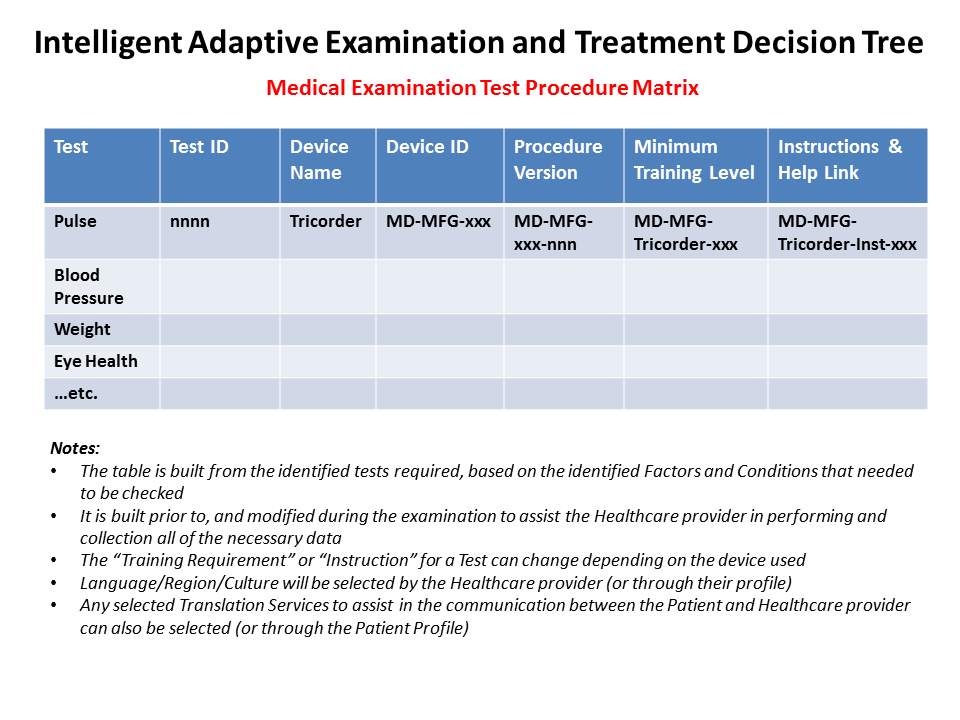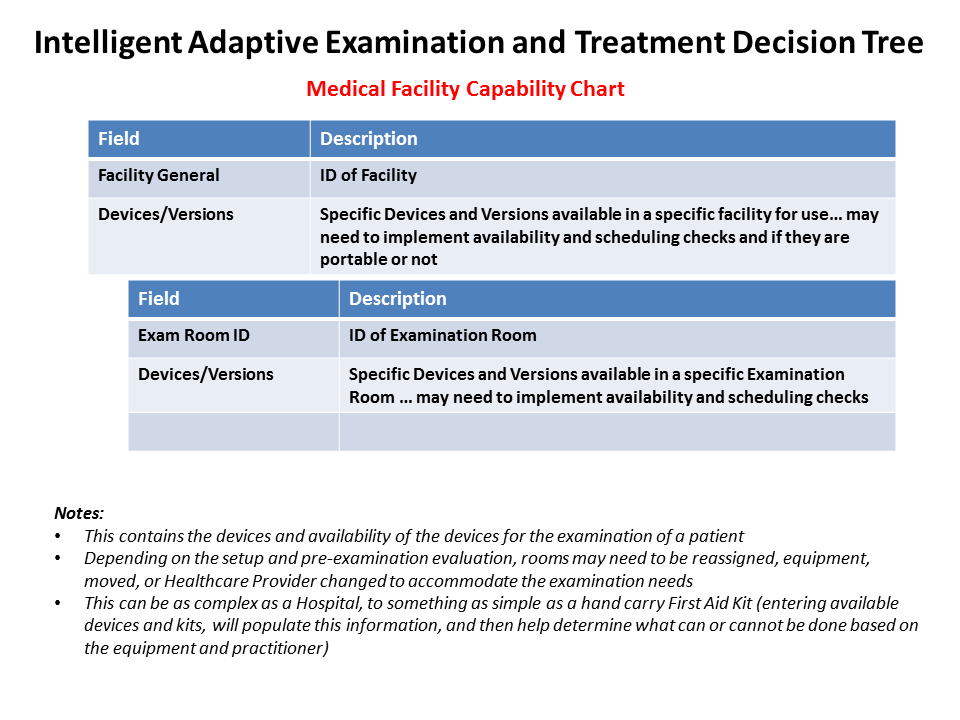This site represents a Technology Based Initiative to create a Worldwide Market-Driven Affordable Whole Healthcare System and is seeking forward thinking and innovative companies, organizations, Universities, and individuals to participate and lead in the Vision, Standards, and the Development of the System... Check back for updates (lots more data to input). Site History

Intelligent Adaptive Examination Decision Tree Features
-
The System supplies step-by-step instructions on phone/tablet (visual or audio), with additional on-line text, audio, and video help(easy to read and in the different individuals native language)
-
Pictures, text, and verbal information can be provided (and translated) in one or more languages (plus culture and belief factors) to support the patient, provider, and any 3rd party consulting that may be needed
-
Patient Questionaries’ (performed by individual, guardian, family, Call Center, or other provider) with Interactive questions and diagrams to help them identify and communicate issues that may have (System will take age, sex, family history, region, culture, religion, etc. into consideration)
-
The System includes canned practical and situational scenarios for training individuals
-
The System uses a wide variety of information to create and modify any tests and data collection during the examination (starting with initial information and then modifying the testing as more data is collected)
-
Past patient baselines, tests, patient information (age, sex, past issues, current issues, family history), and any required follow-ups from previous examines
-
Patients DNA Profile for potential issues
-
Type of examination and time since last examination (any type)
-
Available test equipment/capabilities
-
The qualifications of the individual performing the examination (general level, specific profile/training for some types of testing, cultural differences <e.g. sex of the caregiver>)
-
Test results from patient residential monitoring and tests
-
Testing requested by a doctor
-
Input from an optional online questionnaire that can be filled out by the patient, parent, guardian, and/or volunteer to capture anything that should be covered (as well as any patient personal beliefs)
-
Verbal, visual, audio, and test results during the examination
-
Local standalone and on-line Medical Databases (using inputted symptoms, plus audio and visual baselines and baseline comparisons)
-
Information about current issues in their region (or regions they have recently traveled to)
-
-
The System verifies the collected data at each step across normal and the patients personal historical data
-
The System monitors test devices for calibration and machine events to help determine if they are functioning properly
-
The System shifts a lot of the workload of the examinations to technology
-
Collecting information electronically (verbal, audio, and visual through smartphone/tablet camera, handheld camera, camera glasses, lab setup) through connected devices – Note: Analog results can be viewed with a camera, intelligently interpreted, and then stored (e.g. thermometer, lung pressure, mobility/dexterity)
-
Based on additional information, determine any additional testing
-
Analyzing and Reporting on changes or symptoms of concern (and alerts as necessary)
-
-
The System helps the provider to understand about regional customs and the individuals culture and beliefs
-
The System is constantly updating the Adaptive Examination and Treatment Decision Tree Information providing
-
The latest Information about Conditions and Diseases for a RegionLatest Medical Information available Updated Adaptive Examination and Treatment Paths and Capabilities
-
-
The System can store locally or in Clouds with the capability of HIPAA protections, and providing access to the data anywhere
-
The System is Object Oriented and supports Internationalization/Localization to better communicate between patients and providers and reduce errors
-
Allowing the verbal and written instructions to be in the providers native language, enabling more opportunities for examiners and reaching additional populations
-
Provides information in the patients native language (programed information and translation)
-
-
Intelligent Adaptive Examination Decision Trees can be customized for different Locations and individual Conditions
-
Normal issues/diseases in an area
-
Regional and Individual Differences (Customs, Religion/Beliefs, “Alternative and Complementary Medicines” <Read more about Alternative and Complementary Medicines> vs. "conventional or mainstream medicine”
-
Real-time Update for Emergency Issues (a pandemic, or a disaster like chemicals, radioactivity, gas, earthquake, etc.)
-
-
Special tests can be instantly accessible (or downloaded) into the Decision Tree regionally or worldwide for potential pandemics or epidemics – Scans can also be made across existing patient examines to see any possible correlations to the issue
-
The System integrates a number of additional medical test devices (including new Tricorder type devices, and new applications that can be created on a Smartphone/Tablet), to provide additional testing and baseline that has not been available before in clinics as well as in the field
-
The System supports Telemedicine that can be enabled on any smartphone, tablet, or other voice and video setup.
-
Handle emergency or issues of concern in real-time
-
Have a local location that they can have pre/post-operative consultations where testing can be done and information can be handed out or processed
-
Allows Doctors to review data or have direct contact with Patients anywhere in the world as a paid service or volunteer capacity.
-
This System is not designed to replace doctors, but enables less trained people to do thorough and complete examines, and enhance the tools available to doctors. The System does not replace doctors, but it does:
-
Provide better and more complete examines using the knowledge, experience, and review of the Decision Trees by many doctors in many different regions
-
Simple feedback loop from Doctors (or other providers) of errors or improvements to the decision tree, it’s recommendations, or treatments
-
Provide insight and respect for a medical and healthcare associated with a Patient’s Beliefs
-
Supports the expanded use of Medical assistants (or other trained individuals)
-
To reduce the need for Doctors to perform routine examinations
-
To perform more complete and extensive examinations in rural and relief areas where doctors are not available
-
To perform examinations and emergency treatments when needed (creating different examinations covering experienced to novice caregivers)
-
To provide caregivers with the ability to do additional testing and treatment
-
To provide certain self-examinations for individuals that are concerned about their health or a current issue
-
-
Reduces risks, mistakes, and allows “Virtual Doctor Input” for the exam to get everything that is needed
-
Provides better baseline of the patient’s history and current data, and it provides instant analysis of changes in that data
-
Provides easy to read graphs, data, and identified areas of concern
-
Helps to bring healthcare closer and to more to patients
-
Drives down the costs of Healthcare
The following items are some potential examples of real-time changes in an examination based on input from the patient and/or results from their test results:
-
Any changes in get general vitals and condition (weight, height, blood pressure, pulse, skin color, eyes, general health, etc.)
-
General review of Questionnaire or verbal and pictorial review of current and past issues (in native languages) to identify issues and help narrow them down
-
Additional information provided by the patient during the examination
-
Cold (over 3 days), Lost 10 lbs. in 2 months… ask about, sleep, fatigue, appetite, frequency of colds, difficulty in breathing, sore throats… get blood
-
Apparent change in skin mole (from previous baselines)… describe change, take additional new baselines, check for swelling, etc.
-
Rashes, sores not healing, potential parasite or fungus, discoloration on feet, fingers, or toes… select description (possible matching to on-line pictures), schedule follow-up (or telemedicine)
-
Change in Mobility or Flexibility (arm, leg, back, time to get up, etc.) … check on any increases in pain or decrease in strength
-
Problems seeing or hearing… administer some basic tests
-
Heart, Joint, and Lung audio baselines and issue detection. Take additional information
-
Travel to another country… ask about when the travel occurred, if they have or had certain symptoms, take additional samples for specific checks, things they should watch for
After the Examination
-
Final Report(s) (includes any instructions, recommendations, recommended follow-up, and potentially a “telemedicine” call with a Registered Nurse or Doctor)
-
Patient (no Guardian)
-
Patient (with a Guardian)
-
Guardian
-
Practitioner of examination/treatment
-
Billing/Insurance
-
Doctor (main and/or specifically identified)
-
-
Automatic e-storage of all information for outside review and future use
-
Auto notification to primary caregiver of exam, report, link to data, and any concerns
Notes:
-
Historical data can be pre-downloaded or on-line
-
Decision trees would be defined, reviewed, and constantly upgraded by a review team of doctors
-
Kits to collect samples for labs can be taken or sent in advance and dropped or mailed in
-
Patient rights and release forms may need to be signed prior to examines
-
Personal patient pictures could be a an issue requiring permission and acknowledgement
-
As an option, the examination can be concluded with a review of the information with Doctor, Nurse Practitioner, or RN, on-site or through a queued telemedicine conference.
-
Follow-up reviews or tests can add notes to final reports and affected portions would send notifications to the applicable people and organizations of the updates
Final Reports
Several Reports would be generated and accessible based on the Role that the person or Organization (as well as any required permissions) for the Patient (e.g. Patient (no Guardian), Patient (with a Guardian), Guardian, Caregiver (Practitioner of examination/treatment), Doctor (main and/or specifically identified), Insurance, and Health Network).
Some of the reports would be stored on-line with Access Control Lists to define protections, some could be mailed (attachment or link), and some could be printed and supplied (and reviewed during a Doctor Telemedicine interaction or at the end of the examination or treatment).
Depending on the Role, the following information would be configured in the different Reports (all TBD, but included to show types of data that would be available):
-
General Patient Information (name, address, contacts, insurance, and general condition)
-
Health Provider Information (Primary Physician, Specialists, etc. along with contact information and if they should be notified of any results)
-
Local Practitioner and Site Information
-
Previous areas of concern or watch
-
Recommendations for examinations/treatments and any Doctor adds or Overrides
-
Patient concerns and questions (initial questionnaire and any follow-up)
-
Tests/Examinations/Treatments Performed and results (in dashboard formats showing current values, average values for age, average for individual, and color coded for thresholds)
-
Any results from “Home/Remote Monitoring” (in dashboard formats showing current values, average values for age, average for individual, and color coded for thresholds)
-
Recommended Tests/Examinations/Treatments to be performed (but were not able to be done do to facility or practitioner limitations)
-
Family History
-
Comments and follow-up recommendations from Practitioner
-
Scheduled follow-up activities
-
Ongoing or follow-up Patient/Caregiver instructions
-
Reviewing Doctor comments (if any) during Telemedicine Consultation or after the fact
-
Billing/Treatment Codes
Intelligent Adaptive Examination and Treatment Decision Trees

Intelligent Adaptive Examination Decision Trees allow people without formal and extensive medical training, to be able to collect comprehensive and complete medical information and test data for a Doctor. The feature can also be used in certain treatments of Patients.
This feature has applicability in Hospitals, Clinics, Retirement Homes, Assisted Living Centers, Nursing Facilities, Disaster Relief, Humanitarian Aid, Airplanes, Ships, Corporations, Remote Clinics, Mobile clinics, Private Resorts/Spas, Public Events, Personal Emergencies, etc. The Examinations can ranges from simple First AID to thorough examines and treatments under a variety of worldwide conditions.
Past concerns have been that examinations would not be performed improperly, individuals would make diagnosis that they are not qualified to make, and that subtle information about a patient could be ignored which may be indicative of larger problems. The System tries to take care of all of these concerns as well as additional improvements.















